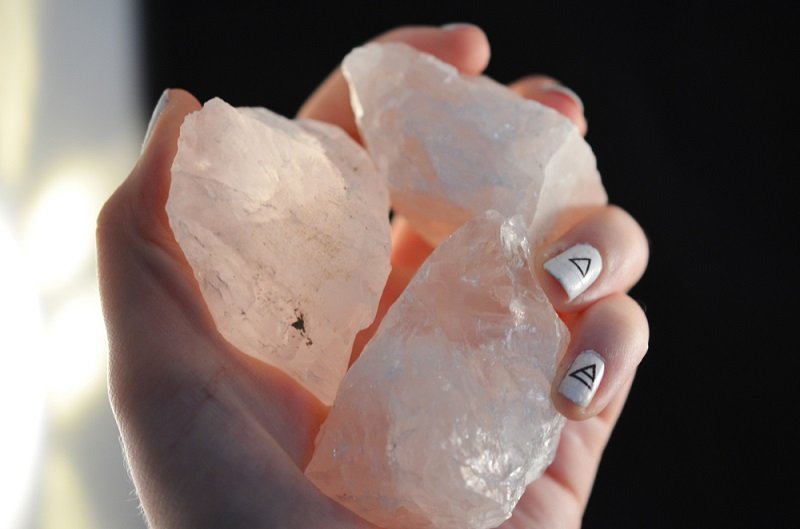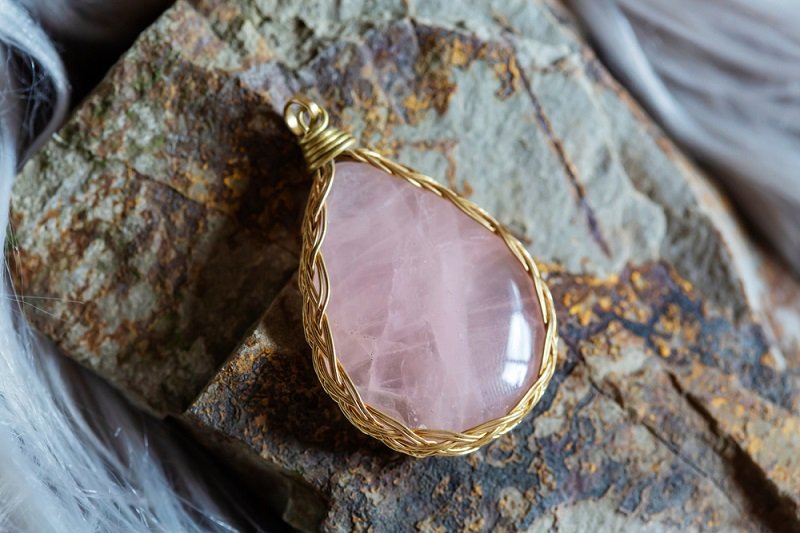One of the staples of the rock trade is rose quartz, a light pink variety of the famous crystals. It’s quite a bit different than the usual crystallized silica, more than most people realize. From the unique inclusions to the way it forms… it’s strange stuff.
So, let’s dig in and talk about some interesting facts about rose quartz!
1. Rose Quartz is Always Massive

When most of us think of quartz, we think of the smaller points that are available at every rock shop. Instead, Rose Quartz often occurs in enormous masses that are inches to feet across. This makes Rose Quartz an ideal medium for hardstone sculptures and other large-scale uses that are rarely seen.
Instead, most Rose Quartz is a bunch of interlocked crystals creating a large mass.
Indeed, Rose Quartz rarely occurs as a natural point or other immediately recognizable crystalline forms. Those available on the market currently are actually a different type of stone, with its own inclusions, that is photosensitive.
This crystalline form is often called pink quartz, or “crystallized rose quartz” and will lose color when exposed to light. It’s all quite complicated when you get down to it, but it’s technically not rose quartz despite the superficial similarities.
Of course, there are also dyed quartz points out there for the unwary to snatch up thinking that they’re getting something rare.
The massive nature of rose quartz is good for one thing: it means virtually every staple of the rock trade (ie: carved points, spheres, palm stones) is available for only a touch more than the cost of labor. They can also be found in a huge variety of sizes, a rarity when most minerals are limited to smaller sizes by the nature of their formation.
Read More: Rose Quartz vs. Strawberry Quartz
2. Its Coloring Ingredient is Debated

Or, more accurately, it appears to vary. While pink might seem to be a rare color in nature, what it really boils down to in stones is that pink is a very dilute red. The coloring agents in different pieces of rose quartz are up for debate.
Read More: What Gives Rose Quartz Its Pink Color?
The usual suspects are iron, titanium, and manganese. All occur alongside quartz formations naturally (ie: the ugly stains on the side of uncleaned crystal formations) and color other gemstones. Iron, in particular, is the coloring ingredient of amethyst, citrine, and prasiolite.
More recent studies point to microscopically thin materials, primarily dumortierite or something similar, as the reagent responsible for the stone’s light pink coloration.
Experiments with synthetic rose quartz have found that aluminum and phosphorous can be irradiated to create the pink color seen in the form of crystalline pink quartz we described above. Like “crystal rose quartz” it also fades in sunlight but irradiation can bring the color back.
I don’t recommend trying that one at home.
It’s interesting to note that a stone with such a long history of use still has unknown variables in something as simple as its atomic structure. Just another reason why rose quartz is such an interesting material.
Speaking of a long history of use…
3. Rose Quartz Has Been Used in Jewelry for Thousands of Years

Beads made of Rose Quartz can be found going back to 6000 BC. Early stone use was often in the form of beads, just showing that the human urge to make pretty things even prettier has been around since we started walking around.
Stone beads require a surprising amount of time and dedication with modern tooling. Drilling something as hard as rose quartz with primitive tools is truly a feat.
Later use of Rose Quartz in jewelry seems to occur in the 800-600BC era, ranging from Rome to the Assyrian Empire and Egypt. The material takes well to carving and it served as another hardstone medium alongside other quartz and chalcedony varieties.
Its ancient provenance has continued to this day.
Rose quartz is rarely cut into faceted gemstones. Facets require a high degree of clarity for the stone to look good and the material often lacks it. That said, cabochons are often cut from large pieces of stone that show good color and are still a feature in jewelry.
The occasional facet can be found, particularly in vintage jewelry, but the ready availability of pink tourmaline has replaced it in all but the best of cases. It’s still a cheap stone, even in the upper grades.
That said, there is one notable exception to this rule: star rose quartz.
4. Some Specimens Display Asterism
Asterism is an optical effect where a stone appears to display a star when the light hits it correctly. In most cases, and Rose Quartz is no exception, this occurs due to rutile inclusions contained in the stone.
In the case of Rose Quartz, exceptional specimens which have a “star” can be quite expensive. Lower-quality samples can be found for a relatively small price for collectors. In jewelry, richly colored cabochons with a centrally located star can get very expensive.
The truth is that the value of these stones is all in the cut and the comparative rarity of asterism in Rose Quartz. I’d venture that thousands of these stones have been cut without the cutter ever knowing that the stone had the potential for asterism.
Asterism’s display largely depends on the quality of the stone cutter’s work, whether it’s a star ruby, garnet, or Rose Quartz. In Rose Quartz, this and the color of the stone will be the determining factor of its value.
Fortunately for collectors, lower-end cabochons meant for the specimen market are still relatively cheap and readily found online.
5. It’s a Recent Discovery in the Americas
While it was known to the ancient world, the history of Rose Quartz in America is much more recent. Specifically, the first deposits on the continent were found in the 1880s, in South Dakota near Custer.
Indeed, Rose Quartz is more common in South Dakota than anywhere in the world. It’s even found in fields and grasslands in the Western portion of the state and it’s the official state mineral.
The Black Hills in South Dakota is a great spot for public collection if you happen to be in the area.
It can also be found in Colorado and North Carolina in large quantities, and there are paid digs available in both areas for those who want to try their hand at collecting.
6. It Has Significant Mythological Signifigance
I rarely comment on the symbolism and “meanings” of stones. It’s a bit of a quagmire if you start digging, and most of the “ancient uses” of stones are distinctively modern. No need to take my word on this one, compare what you find on Google to the uses and meanings found in older occult texts like The Three Books of Occult Philosophy collected by Heinrich Cornelius Agrippa.
Then keep in mind those texts are built on still older ones. There’s a stark difference, and there’s a lot of faith and belief involved.
However, Rose Quartz has held mythological significance for the Grecian and Roman pantheons since those nations were still dominant forces in the world. Specifically, Rose Quartz has been associated with the tail of Adonis and Aphrodite.
In ancient legends, Adonis was an exceptionally handsome hunter who was a favorite of the love goddess Aphrodite. At one point, he was beseeched by the goddess not to go on a hunt, as it was too dangerous.
He went, as people do, and was promptly killed. Whether it was by a boar or Ares (the god of war and divine lover of Aphrodite) is up to the source. When Aphrodite rushed to meet him, she pricked herself on a thorny bush and her blood mingled with that of Adonis on a quartz stone it changed color and became the “stone of love” or rose quartz.
This was a common feature of Grecian myths, for instance, the Saffron Crocus was said to come from Hermes’ grief at losing a mortal lover and the blood which fell from his head. Plants and stones were often created as signs of these momentous passings.
Regardless of the exact origins of the story, Rose Quartz holds a special place in human history and it continues to hold a sacred meaning to many to this very day.
- Online rock and mineral club for collectors of all levels!
- Find community with like-minded rock and mineral enthusiasts.
- Monthly Giveaways!
- Free Access to Entire Digital Library of Products (current and future products)*


